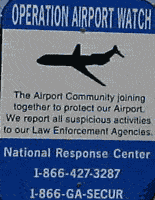Delta Scientific, a manufacturer of counter-terrorist vehicle control systems used in the United States and internationally, recently announced that it has sold systems deploying more than 400 DSC2000 shallow foundation barricades to customers throughout the world.
The Transportation Security Administration (TSA) and Port of Los Angeles worked together to open an additional enrollment site recently on Terminal Island in an effort to facilitate enrollment for the Los Angeles/Long Beach port worker, mariner and trucker communities into the federal Transportation Worker Identification Credential (TWIC) program.
The exercise was held June 25 at Washington's Union Station and brought transportation entities from the national capital region together to reinforce strategic plans for preventive and protective response in the event of emergency situations.
The ASIS Commission on Standards and Guidelines has released the second edition of the Threat Advisory System Response Guideline (TASR).
Building automation has revitalized public safety in Puerto Rico by employing a video surveillance system that improves communication throughout the police force and centralizes public housing issues.
- By Ralph C. Jensen
- Jun 30, 2008
Congress reaffirmed its will to implement 100-percent scanning in four years while government witnesses defended their position that the deadline was unrealistic.
If you’re a security integrator working with companies that store or produce chemical or petroleum products, your clients have probably asked for assistance with the Department of Homeland Security’s Chemical Facilities Anti- Terrorism Standards.
- By Matt Scherer
- May 21, 2008
The maritime industry is clearly one of the most powerful drivers of international commerce and economic vitality in the world. The statistics are astounding, including a worldwide fleet of nearly 11 million marine containers, a transportation cargo unit that can hold up to 500 computer monitors.
- By John Diedam
- May 21, 2008
A fingerprint identification technology for use in Personal Identification Verification (PIV) cards that offers improved protection from identity theft meets the standardized accuracy criteria for federal identification cards according to researchers at the National Institute of Standards and Technology.
GovSec, U.S. Law and Ready has wrapped up its Washington, D.C. tradeshow, and one event truly has captured the essence of helping others in a meaningful way. Tradeshow officials have teamed up with Verizon Wireless to support HopeLine.
- By Ralph C. Jensen
- Apr 30, 2008
Intelli-Check/Mobilisa Inc. recently announced that it will be launching its latest product, the IM 2700 -- Transportation Worker Card Reader at GovSec, U.S. Law and Ready.
USIS, a provider of pre-employment screening and the largest provider of security investigations to the U.S. government, is launching a new service by the Special Investigations Unit (SIU) of the company’s Investigative Services Division (ISD).
GovSec 2008 is in the books. I like saying it that way because it reminds me of when I coached baseball. In the books meant it was a good game, and we likely won. GovSec was a good tradeshow, and exhibitors likely won.
- By Ralph C. Jensen
- Apr 25, 2008
videoNEXT, a developer of security management solutions, recently announced in a collaborative effort with SightLogix Inc, that the two companies have completed the implementation of a video surveillance system for a high-security military installation.
Pivot3 will exhibit the company's High-Definition Storage at Booth 2527 during GovSec, U.S. Law and Ready.
Homeland Security Group has launched its new PDVR-1000, a waterproof, body-worn DVR that strongly improves security for agents in the field, offers evidential quality recording of suspects and allows supervisors to coordinate tactical operations.
GovSec, U.S. Law and Ready kicked off its first edition Wednesday since the 1105 Media team bought the event. A strong list of keynote speakers will highlight daily activities.
- By Ralph C. Jensen
- Apr 24, 2008
In recent testimony before the U.S. House Subcommittee on Government Management, Organization and Procurement, Rob Zivney called implementation of HSPD-12 a pioneering effort which will require both a financial investment and development of new infrastructure.

When hurricanes in 2005 leveled the Charlotte County Airport in Punta Gorda, Fla., airport officials chose to rebuild, and to do so stronger and smarter. That meant making sure the airport’s security system satisfied federal and state regulations in a post-9/11 world that had to protect against potential terrorists turning airplanes into deadly bombs.
- By Debbie Bolles
- Apr 08, 2008

Immigration is one of those controversial issues that touch on many aspects of American life. It's challenging because on one hand, there are those who come to the United States to seek a better life. But in doing so, they are breaking the law. Three people believe they have the answers to resolve this issue, and oddly enough, all three want to be president of the United States.
- By Ralph C. Jensen
- Apr 02, 2008
More than 900 federal, state and local law enforcement and homeland security officials recently attended the National Fusion Center Conference in Washington, D.C. to further the U.S. government’s plans to create a seamless network of these centers.
Officials from the United States and Germany recently initialed a bilateral agreement related to sharing access to biometric data and spontaneous sharing of data about known and suspected terrorists.
Cyber Storm II is the second in a series of congressionally mandated exercises that will examine the nation’s cyber security preparedness and response capabilities. The exercise will simulate a coordinated cyber attack on information technology, communications, chemical, and transportation systems and assets.
The associations joined in an amicus brief urging the 10th Circuit Court of Appeals to agree that the Oklahoma statute, by forcing employers to allow guns such as this Beretta, runs afoul of the General Duty Clause.
One of the first reactionary attempts to bolster security after 9/11 occurred at airports. Immediately after air service was reinstated, the public saw uniformed Marines armed with M-16s at every security checkpoint, concrete barriers at each entry point, security guards ransacking passengers’ luggage and, of course, taller fences going up around airfield perimeters. As with most things in life, an unexpected event usually generates an unexpected— and sometimes irrational— response. Such was the case with the nation’s aviation facilities.
- By Barry Willingham
- Mar 03, 2008

Mention border security, and you might imagine the intersection of two countries, or perhaps the border separating government facilities from private land. But border security also can be defined as perimeter security, which expands the concept to encompass walls, fences, roads and other perimeters around businesses, schools, prisons, utilities, research facilities, and other properties and buildings.
- By John Monti
- Mar 01, 2008
A rapid way to spot insider threats from individuals within an organization such as a multinational company or military installation is reported in the current issue of the International Journal of Security and Networks.
The Department of Homeland Security (DHS) announced recently that it will further advance the department’s Homeland Security Presidential Directive-12 (HSPD-12) goals by awarding contracts to three companies.
The Federal Bureau of Investigation recently awarded Lockheed Martin a 10-year, $1 billion contract to develop and maintain the Bureau's Next Generation Identification (NGI) system, a multi-modal, state-of-the-art biometrics system for use by state, local and federal authorities.
An interagency subcommittee of the White House's National Science and Technology Council (NSTC) issued a draft document recently that lists recommended standards to enable government agencies to easily share biometric data.
Sure, it's just a TV show, but a University of Iowa law professor says 24 can have real-world legal implications
The Department of Homeland Security (DHS) recently announced an increase in the total amount of funding available for REAL ID implementation and an extension in the deadline for FY 2008 REAL ID Demonstration Grant Program applications.
The final rule for REAL ID compliance provides the necessary guidance for states to begin building systems and linking networks to fulfill the mandates of the 2005 legislation, according to a newly released report by INPUT.

The Federal Energy Regulatory Commission (FERC) recently approved eight new mandatory critical infrastructure protection (CIP) reliability standards to protect the nation’s bulk power system against potential disruptions from cyber security breaches.
McAfee Inc. recently presented the McAfee Cybercrime Fighter Award to Gregory T. Garcia, Assistant Secretary for Cyber Security and Communications at the Department of Homeland Security.
The Department of Homeland Security recently released the National Response Framework, successor to the National Response Plan.

The average small-business owner may view the world of federal government contracts as an intimidating, mind-boggling realm dominated by huge corporations— with the promise of great financial success just out of reach. However, breaking into the federal government marketplace is a feat that can be accomplished by small private companies—and one that has been achieved by countless organizations, especially in recent years.
- By Megan Weadock
- Jan 07, 2008

In the United States, people encounter a perpetual tradeoff between freedom and security. The nation depends on a complex system of critical infrastructures to maintain a high quality of life and the freedoms enjoyed every day. New threats to security have these organizations taking a second look at their vulnerabilities, however, scrambling to minimize disruption and to maintain the integrity of their operations. In the past, national security was perceived as the role of government. Today, Department of Homeland Security efforts to protect critical infrastructures from physical attack are a shared responsibility of the public and private sectors, as well as individual citizens.
Correctional facility infrastructures are aging, inmate populations in the United States are increasing, and the cost of operating jails and prisons is growing twice as fast. Correctional facility officials know these facts all too well.
- By Felix Gonzalez
- Jan 03, 2008
TSA recently announced the appointment of Kimberly Hubbard Walton as the assistant administrator for the Office of the Special Counselor (OSC).
The Department of Homeland Security’s publication of chemical facilities anti-terrorism (CFAT) standards has many chemical and petrochemical companies scrambling to develop security plans for their high-risk facilities. The continued post-9/11 threat of terrorism dictates urgency, and the DHS put teeth in the CFAT rules.
- By Carol Enman
- Dec 04, 2007
Gemalto's vice president urged DHS and congress to make privacy and data security the highest priorities in ID programs.
SI International announced recently that it is a member of the KT Consulting team that has been awarded the IT Services, Program Support Services contract with DoD and WHS.
A recent report from INPUT projects the federal market for identity and access management to grow by 6.2 percent annually through 2012.

IT seems a shame to have to start yet another article on security with the words “in the aftermath of 9/11.” However, when it comes to protecting national monuments and treasures, the fact is security has had to change significantly in the past six years as a result of heightened terrorism concerns.
- By Bill Lozon
- Sep 21, 2007

GOVERNMENT security has been the subject of unprecedented focus since 9/11. Before the attacks, advanced physical security was considered a necessary expenditure only for military facilities and key government installations in high-target areas around the world. Before 9/11, people were comfortable with security and confident terrorism would never touch the country directly on home soil.
- By John Waldron
- Apr 04, 2007

NAVIGATING the world of federal government contracts can be a head-spinning operation for even the most committed and headstrong business.
But for many, working with the federal government, especially with the constantly growing Department of Homeland Security, is too big a proposition to pass up. With 183,000 employees and a budget of more than $42.7 billion in fiscal year 2007, DHS is the third-largest cabinet department in the federal government and a target for many companies to garner new business.
- By Brent Dirks
- Feb 05, 2007
U.S. airports with one or more checkpoint areas, security officials have probably never thought of themselves as ID managers.
- By Yotam Margalit
- Jan 24, 2007
SECURING the flow of oil from offshore platforms, land-based drilling rigs and pumping stations across miles of pipeline and infrastructure is a top priority for the government and the petroleum industry.
- By Brooks McChesney
- Jan 24, 2007

PROVIDING adequate airport security has become an ongoing debate of national importance after being plunged into a post-9/11 world. Who can forget the eerie sight of an empty sky during the immediate days following the infamous attack in the nation's history.
- By Jeff Brummet
- Jan 23, 2007
THE Transportation Security Administration is doing a good job protecting air travelers. Likewise, airport security managers are working hard to keep the public safe and to speed us through the facilities. Until recently, getting through airport security was technologically simple -- bags were run through an X-ray scanner while walking through a conventional metal detector.
- By Col. Timothy D. Ringgold
- Jan 03, 2007
SEPTEMBER 2006 marked the fifth anniversary of the Sept. 11, 2001, attacks on the World Trade Center, sparking widespread debate on whether the United States is any safer today than it was on that fateful day in 2001. Since 9/11, much has been done to promote greater vigilance of both foreign and homegrown terrorist activities. But until another successful or unsuccessful terrorist attack, the nation may never know the complete answer.
- By Mike Hammons
- Jan 02, 2007
NOWADAYS, it takes much more to have a safe flight, and airports are strengthening security to ensure passengers do travel safely.
- By Courtney Dillon Pederson
- Jan 01, 2007
SECURITY, a once seemingly mundane staple of American life, has seen a drastic reconstruction in recent years. In part, protecting utility infrastructures has sped to the forefront of the debate. Water, and its infrastructure for delivery, has been no exception.
- By Brent Dirks
- Jan 01, 2007
THE fluctuating state of global migration, combined with international terrorism threats, make ID verification increasingly important at border crossings. According to Customs and Border Protection, in 2005, the United States had an average of 1.2 million visitors per day at the 314 land, air and seaports last year.
- By Alain Jutant
- Dec 01, 2006
AFTER returning from a business trip earlier this week, I undertook the all too familiar task of sorting through mail, newspapers and magazines that had accumulated during my absence.
- By Col. Timothy D. Ringgold
- Dec 01, 2006
THE security of critical infrastructure and facilities is vital in today's world. With recent advances in technology, there are more choices on how to protect facilities from crime, terrorism, sabotage and intruders.
IN the last four and a half years, new government mandates for tighter physical security at critical infrastructure sites have led to significant strides in physical access control innovation.
- By Walter Hamilton
- Oct 01, 2006
THE shelves in the Wi-Fi network candy store are filling up with the newest products fresh from the factory.
- By Gary Bradt
- Sep 01, 2006
THE legal environment for small businesses has dramatically changed over the past few years, starting with the fraudulent activities of companies, such as Enron, along with the rash of high profile information thefts at Choicepoint and Lexis-Nexis.
- By Guy Morgan
- Sep 01, 2006